 The link below is to an article by Bill Gates, founder of Microsoft. He argues that per-capita GDP is a poor indicator of development, especially in Sub-Saharan Africa.
The link below is to an article by Bill Gates, founder of Microsoft. He argues that per-capita GDP is a poor indicator of development, especially in Sub-Saharan Africa.
The problems with using GDP as an indicator of the level of development of a country are well known and several alternative measures are in common use. Perhaps the best known is the United Nations Development Programme’s Human Development Index (HDI), where countries are given an HDI of between 0 and 1. HDI is the average of three indices based on three sets of variables: (i) life expectancy at birth, (ii) education (a weighted average of (a) the mean years that a 25-year-old person or older has spent in school and (b) the number of years of schooling that a 5-year-old child is expected to have over their lifetime) and (iii) real gross national income (GNY) per capita, measured in US dollars at purchasing-power parity exchange rates (see Box 27.1 in Economics 8th edition for more details).
 But although indicators such as this capture more elements of development than simple per-capita GNP or GNY, there are still serious shortcomings. A major problem is the lack of and inaccuracy of statistics, especially when applied to the rural subsistence and informal urban sectors. The problem is recognised and some countries are trying to address the problem (see the second article below), but the problem is huge. As Gates says:
But although indicators such as this capture more elements of development than simple per-capita GNP or GNY, there are still serious shortcomings. A major problem is the lack of and inaccuracy of statistics, especially when applied to the rural subsistence and informal urban sectors. The problem is recognised and some countries are trying to address the problem (see the second article below), but the problem is huge. As Gates says:
It is clear to me that we need to devote greater resources to getting basic GDP numbers right. … National statistics offices across Africa need more support so that they can obtain and report timelier and more accurate data. Donor governments and international organisations such as the World Bank need to do more to help African authorities produce a clearer picture of their economies. And African policymakers need to be more consistent about demanding better statistics and using them to inform decisions.
Another problem is how you convert data into internationally comparable forms. For example, how are inflation, exchange rates, income distribution, the quality of health provision and education, etc. taken into account?
How GDP understates economic growth The Guardian, Bill Gates (8/5/13)
States’ GDP computation report out soon, says Nigeria statistics bureau Premium Times (Nigeria), Bassey Udo (9/5/13)
Michael Porter Presents New Alternative to GDP: The Social Progress Index (SPI) Triple Pundit, Raz Godelnik (13/4/13)
Questions
- By accessing the Human Development Index site, identify which countries have a much higher ranking by HDP than by per capita gross national income. Explain why.
- Why is expressing GNY in purchasing-power parity (PPP) terms likely to increase the GNY figures for the poorest countries?
- Explain the following quote from the Gates article: ‘I have long believed that GDP understates growth even in rich countries, where its measurement is quite sophisticated, because it is very difficult to compare the value of baskets of goods across different time periods’.
- Why is GNY per capita, even when expressed in PPP terms, likely to understate the level of development in subsistence economies?
- Explain whether the rate of growth of GNY per capita is likely to understate or overstate the rate of economic development of sub-Saharan African countries?
- Why are the challenges of calculating GDP or GNY particularly acute in sub-Saharan Africa?
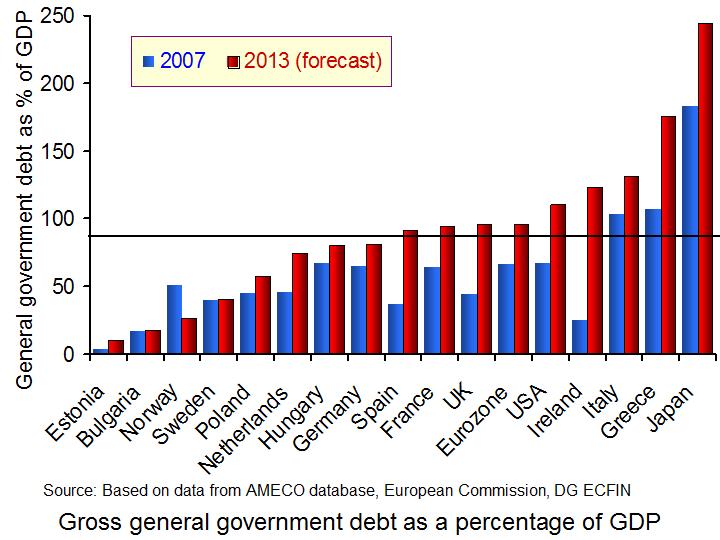 High levels of government debt and the adverse effect this has on the economy has been a key influencing factor in the fiscal consolidation efforts across the world. A key factor providing evidence in support of the connection between high government debts and low economic growth was a paper by two Harvard economists. However, the data used in their research has been called into question.
High levels of government debt and the adverse effect this has on the economy has been a key influencing factor in the fiscal consolidation efforts across the world. A key factor providing evidence in support of the connection between high government debts and low economic growth was a paper by two Harvard economists. However, the data used in their research has been called into question.
As we saw in a previous post, It could be you, Carmen Reinhart and Kenneth Rogoff presented a paper back in January 2010. Their research suggested that when a country’s debt increases above 90% of GDP, economic growth will slow considerably. (Click here for a PowerPoint of the above chart.) As you might expect, given the timing of this research, policymakers were intrigued. For those governments in favour of cuts in government spending and increases in taxation to bring the government debt down, this research was dynamite. It seemed to provide the evidence needed to confirm that if left to grow, government debt will have a significantly adverse effect on growth. Here was evidence in favour of austerity.
But, did a simple error create misleading information? A student at the University of Massachusetts Amherst was trying to replicate the results found by Reinhart and Rogoff, but was unable to do so. Thomas Herndon contacted the Harvard professors and they sent him the spreadsheets they had used in their calculations. Looking through it, an error in calculating the average GDP was spotted. However, the student and his supervisors also engaged in further research and came across other inconsistencies. This led to a draft working paper being published in April. The paper did find the same correlation between high debt levels and low growth, but the outstanding results found by Reinhart and Rogoff disappeared. Responding to the error, the Harvard professors said:
We are grateful to Herndon et al. for the careful attention to our original Growth in a Time of Debt AER paper and for pointing out an important correction to Figure 2 of that paper. It is sobering that such an error slipped into one of our papers despite our best efforts to be consistently careful. We will redouble our efforts to avoid such errors in the future. We do not, however, believe this regrettable slip affects in any significant way the central message of the paper or that in our subsequent work.
So, how might this correction and the implications affect government policy? Are we likely to see a reversal in austerity measures? Only time will tell.
Articles
Seminal economic paper on debt draws criticism Wall Street Journal, Brenda Cronin (16/4/13)
Reinhart, Rogoff … and Herndon: The student who caught out the Profs BBC News, Ruth Alexander (20/4/13)
Reinhart and Rogoff publish formal correction Financial Times, Robin Harding (8/5/13)
The 90% question The Economist (20/4/13)
Reinhart and Rogoff correct austerity research error BBC News (9/5/13)
Harvard’s Reinhart and Rogoff publish formal collection CNBC, Robin Harding (9/5/13)
Rogoff and Reinhart should show some remorse and reconsider austerity The Guardian, Heidi Moore (26/4/13)
The buck does not stop with Reinhart and Rogoff Financial Times, Lawrence Summers (5/5/13)
Meet Carmen Reinhart and Kenneth Rogoff, the Harvard professors who thought they had austerity licked – and Thomas Herndon, the student who proved them wrong Independent, Tim Walker (22/4/13)
Papers
Growth in a time of debt American Economic Review (May 2010)
Does high public debt consistently stifle economic growth? A critique of Reinhart and Rogoff Political Economy Research Institute, Herndon, Ash and Pollin (April 2013)
Questions
- How do high government debts arise?
- In order to reduce government debts, cuts in government spending and increases in taxation are advocated. How does theory suggest that these changes in fiscal policy will affect economic growth?
- What are the arguments (a) in favour of and (b) against austerity measures?
- How might the correction made by Reinhart and Rogoff affect policymakers and their austerity plans?
- What are the key messages from Reinhart and Rogoff’s paper?
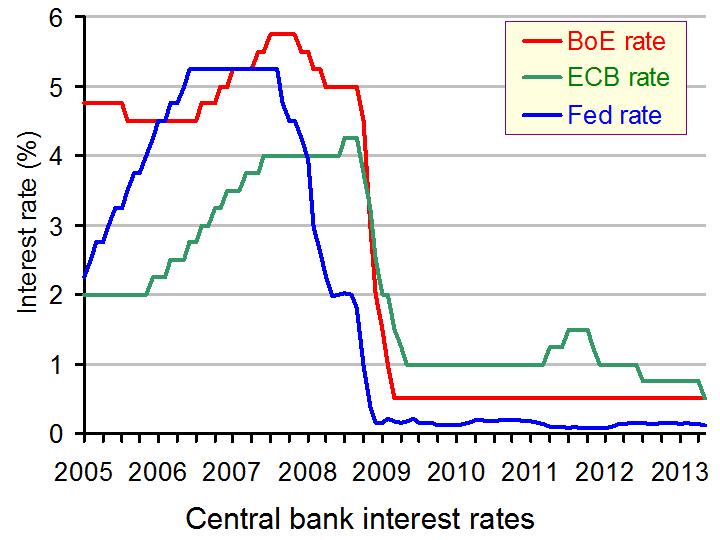 Interest rates have, for some years, been the main tool of monetary policy and of steering the macroeconomy. Across the world interest rates were lowered, in many cases to record lows, as a means of stimulating economic growth. Interest rates in the UK have been at 0.5% since March 2009 and on 2nd May 2013, the ECB matched this low rate, having cut its main interest rate from 0.75%. (Click here for a PowerPoint of the chart.)
Interest rates have, for some years, been the main tool of monetary policy and of steering the macroeconomy. Across the world interest rates were lowered, in many cases to record lows, as a means of stimulating economic growth. Interest rates in the UK have been at 0.5% since March 2009 and on 2nd May 2013, the ECB matched this low rate, having cut its main interest rate from 0.75%. (Click here for a PowerPoint of the chart.)
Low interest rates reduce the cost of borrowing for both firms and consumers and this in turn encourages investment and can boost consumer expenditure. After all, when you borrow money, you do it to spend! Lower interest rates will also reduce the return on savings, again encouraging spending and for those on variable rate mortgages, mortgage payments will fall, increasing disposable income. However, these above effects are dependent on the banks passing the ECB’s main interest rate on its customers and this is by no means guaranteed.
Following the cut in interest rates, the euro exchange rate fell almost 2 cents against the dollar.
Interest rates in the eurozone have been at 0.75%, but a 0.25 point cut was widely expected, with the ongoing debt crisis in the Eurozone continuing to adversely affect growth and confidence. A lack of trust between banks has also contributed to a lack of lending, especially to small and medium sized enterprises. The ECB has injected money into financial institutions with the aim of stimulating lending, but in many cases, banks have simply placed this extra money back with the ECB, rather than lending it to other banks or customers. The fear is that those they lend to will be unable to repay the money. In response to this, there have been suggestions of interest rates becoming negative – that is, if banks want to hold their money with the ECB they will be charged to do it. Again, the idea is to encourage banks to lend their money instead.
Small and medium sized businesses have been described as the engine of growth, but it is these businesses who have been the least able to obtain finance. Without it, they have been unable to grow and this has held back the economic recovery. Indeed, GDP in the Eurozone has now fallen for five consecutive quarters, thus prompting the latest interest rate cut. A key question, however, will be how effective this quarter of a percent cut will be. If banks were unwilling to lend and firms unwilling to invest at 0.75%, will they be more inclined at 0.5%? The change is small and many suggest that it is not enough to make much of a difference. David Brown of New View Economics said:
The ECB rate cut is no surprise as it was well flagged by Draghi at last month’s meeting. Is it enough? No. The marginal effect of the cut is very limited, but at least it should have some symbolic rallying effect on economic confidence.
This was supported by Howard Archer at HIS Global Insight, who added:
Admittedly, it is unlikely that the trimming of interest rates from 0.75% to 0.5% will have a major growth impact, especially given fragmented credit markets, but any potential help to the eurozone economy in its current state is worthwhile.
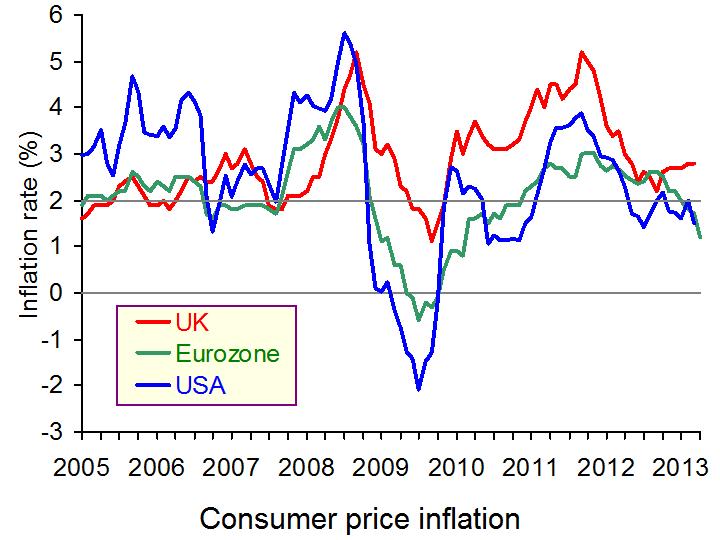 Inflation in the eurozone is only at 1.2%, which is significantly below the ceiling of 2%, so this did give the ECB scope for the rate to be cut. (Click here for a PowerPoint of the chart.) After all, when interest rates fall, the idea is to boost aggregate demand, but with this, inflation can emerge. Mr Draghi said ‘we will monitor very closely all incoming information, and assess any impact on the outlook for price stability’. The primary objective of the ECB is the control of inflation and so had inflation been somewhat higher, we may have seen a different decision by the ECB. However, even then, 5 consecutive quarters of negative growth is hard to ignore.
Inflation in the eurozone is only at 1.2%, which is significantly below the ceiling of 2%, so this did give the ECB scope for the rate to be cut. (Click here for a PowerPoint of the chart.) After all, when interest rates fall, the idea is to boost aggregate demand, but with this, inflation can emerge. Mr Draghi said ‘we will monitor very closely all incoming information, and assess any impact on the outlook for price stability’. The primary objective of the ECB is the control of inflation and so had inflation been somewhat higher, we may have seen a different decision by the ECB. However, even then, 5 consecutive quarters of negative growth is hard to ignore.
So, if these lower interest rates have little effect on stimulating an economic recovery, what about a movement away from austerity? Many have been calling for stimulus in the economy, arguing that the continuing austerity measures are stifling growth. The European Council President urged governments to promote growth and job creation. Referring to this, he said:
Taking these measures is more urgent than anything … After three years of firefights, patience with austerity is wearing understandably thin.
However, Mr. Draghi urged for policymakers to stick with austerity and continue to focus on bringing debt levels down, while finding other ways to stimulate growth, including structural reform. The impact of this latest rate cut will certainly take time to filter through the economy and will very much depend on whether the 0.5% interest rate is passed on to customers, especially small businesses. Confidence and trust within the financial sector is therefore key and it might be that until this emerges, the eurozone itself is unlikely to emerge from its recession.
ECB ready to enter unchartered waters as bank cuts interest rate to fresh low of 0.5pc The Telegraph, Szu Ping Chan (2/5/13)
Draghi urges Eurozone governments to stay the course on austerity Financial Times, Michael Steen (2/5/13)
Eurozone interest rates cut to a record low of 0.5% The Guardian, Heather Stewart (2/5/13)
ECB’s Draghi ‘ready to act if needed’ BBC News (2/5/13)
Eurozone interest rates cut again as ECB matches Bank of England Independent, Russell Lynch (3/5/13)
Margio Draghi urges no let-up in austerity reforms after Eurozone rate cut – as it happened The Guardian, Graeme Wearden (2/5/13)
ECB cuts interest rate to record-low 0.5% in desperate measure to drag Eurozone out of recession Mail Online, Simon Tomlinson and Hugo Duncan (2/5/13)
ECB cuts interest rates, open to further action Reuters, Michael Shields (2/5/13)
Eurozone loosens up austerity, slowly Wall Street Journal (2/5/13)
ECB cuts interest rate, not enough to pull the region out of recession The Economic Times of India (2/5/13)
Euro steady ahead of ECB interest rate announcement Wall Street Journal, Clare Connaghan (2/5/13)
 European Central Bank (ECB) cuts interest rates BBC News (2/5/13)
European Central Bank (ECB) cuts interest rates BBC News (2/5/13)
All eyes on ECB as markets expect rate cut Financial Times, Michael Steen (2/5/13)
Questions
- How is a recession defined?
- Using an aggregate demand/aggregate supply diagram, illustrate and explain the impact that this cut in interest rates should have.
- On which factors will the effectiveness of the cut in interest rates depend?
- Using the interest rate and exchange rate transmission mechanisms to help you, show the impact of interest rates on the various components of aggregate demand and thus on national output.
- What would be the potential impact of a negative interest rate?
- Why did the low inflation rate give the ECB scope to cut interest rates?
- What are the arguments for and against austerity measures in the Eurozone, given the 5 consecutive quarters of negative growth?
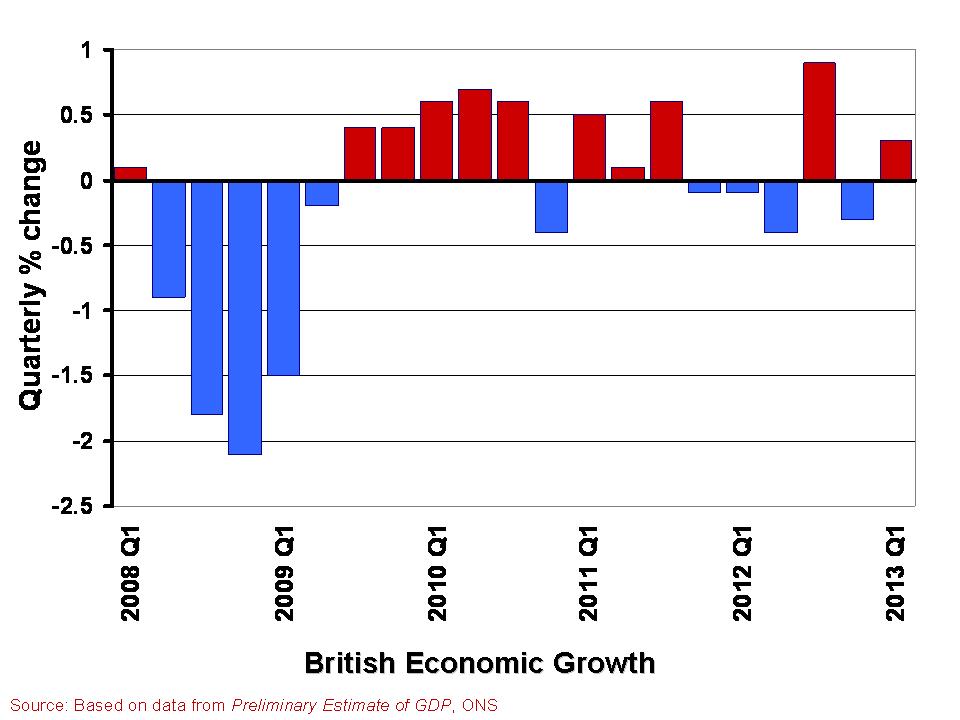 In The global economy we note the mixed picture contained within the latest British growth numbers. With the first estimate of growth for Q1 of 2013 pointing to an increase in real GDP of 0.3 per cent, the UK economy appears to have missed the ignominy of a triple dip recession. However, the overall economy remains fragile with different sectors of the economy performing quite differently.
In The global economy we note the mixed picture contained within the latest British growth numbers. With the first estimate of growth for Q1 of 2013 pointing to an increase in real GDP of 0.3 per cent, the UK economy appears to have missed the ignominy of a triple dip recession. However, the overall economy remains fragile with different sectors of the economy performing quite differently.
A patchy picture is perhaps the fairest assessment. This helps to explain the quite different perceptions amongst economists, business people, journalists and the wider public about the current state of the economy. Here we consider in a little more detail the growth numbers for the UK from the latest preliminary GDP estimates. (Click here for a PowerPoint of the chart).
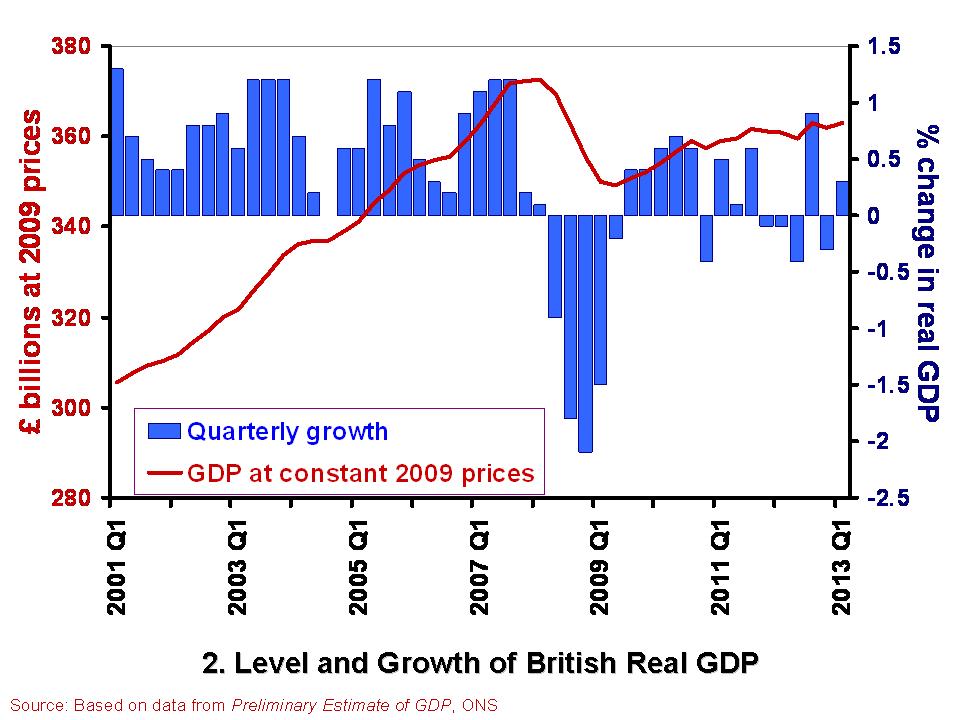 The British economy is thought to have grown by 0.3 per cent in the first quarter of 2013. This follows a contraction of 0.3 per cent in the final quarter of 2012. Compared with the first quarter of 2012, the output of the British economy was 0.6 per cent higher. However, as Chart 2 helps to show, the British economy has some way to go before it returns to the levels seen prior to the financial crisis. Real GDP peaked in the first quarter of 2008 when GDP at 2009 prices was estimated at £372.7 billion. In the first quarter of 2013, GDP at constant 2009 prices is estimated at £362.9 billion. This means that the economy is still 2.6 per cent smaller than its 2008-peak. Click here for a PowerPoint of the chart.
The British economy is thought to have grown by 0.3 per cent in the first quarter of 2013. This follows a contraction of 0.3 per cent in the final quarter of 2012. Compared with the first quarter of 2012, the output of the British economy was 0.6 per cent higher. However, as Chart 2 helps to show, the British economy has some way to go before it returns to the levels seen prior to the financial crisis. Real GDP peaked in the first quarter of 2008 when GDP at 2009 prices was estimated at £372.7 billion. In the first quarter of 2013, GDP at constant 2009 prices is estimated at £362.9 billion. This means that the economy is still 2.6 per cent smaller than its 2008-peak. Click here for a PowerPoint of the chart.
The patchy nature of British growth is illustrated nicely by the contrasting rates of growth across the different industrial sectors in the first quarter of the year. While service sector output rose by 0.6 per cent, output across the production industries rose by only 0.2 per cent and agricultural output declined by 3.7 per cent. Within the production industries, mining and quarrying output rose by 3.2 per cent, but manufacturing output shrunk by 0.3 per cent and construction output shrunk by 2.5 per cent.
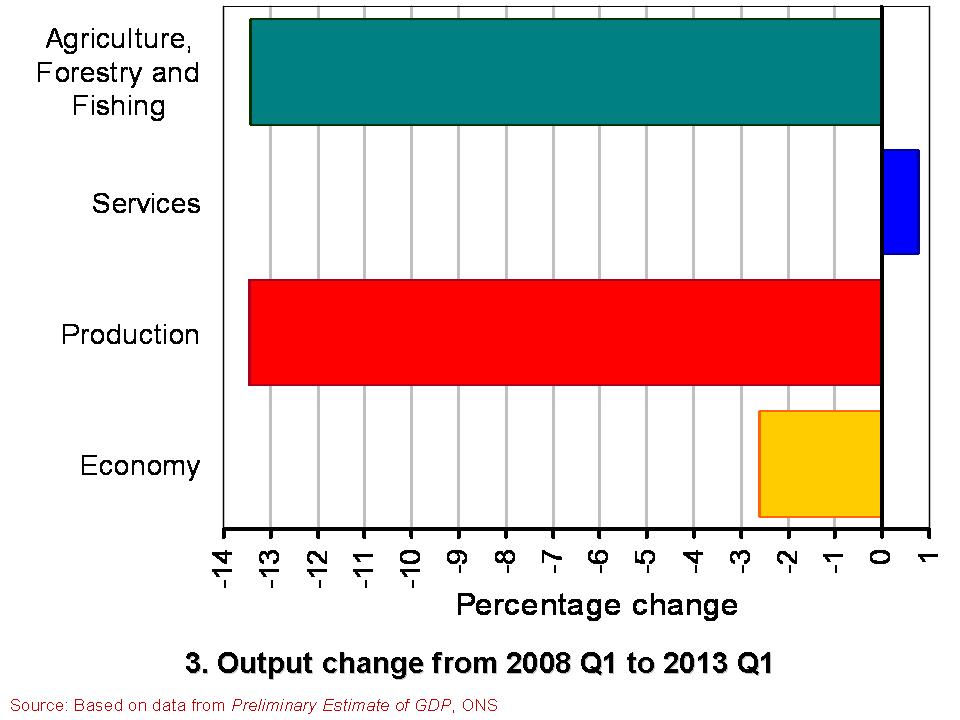 Chart 3 compares the output of agriculture, the production industries and the service sector between the first quarter of 2008 and the first quarter of 2013. (Click here for a PowerPoint of the Chart). It shows the dramatically different experience of the service sector compared with agriculture and the production industries. While output in the service sector is now 0.8 per cent higher, output across agriculture and the production industries is almost 13.5 per cent lower. Within the production industries, output in mining and quarrying is 38 per cent lower, in the construction sector 19 per cent lower and 10 per cent lower in manufacturing. It is perhaps not surprising then that we get such different messages about the state of the economy. The devil really is in the detail.
Chart 3 compares the output of agriculture, the production industries and the service sector between the first quarter of 2008 and the first quarter of 2013. (Click here for a PowerPoint of the Chart). It shows the dramatically different experience of the service sector compared with agriculture and the production industries. While output in the service sector is now 0.8 per cent higher, output across agriculture and the production industries is almost 13.5 per cent lower. Within the production industries, output in mining and quarrying is 38 per cent lower, in the construction sector 19 per cent lower and 10 per cent lower in manufacturing. It is perhaps not surprising then that we get such different messages about the state of the economy. The devil really is in the detail.
Data
Preliminary Estimate of GDP – Time Series Dataset Q1 2013 Office for National Statistics
Statistical Bulletin: Gross Domestic Product Preliminary Estimate Q1 2013 Office for National Statistics
Articles
UK avoids triple-dip recession with better-than-expected 0.3% GDP growth Guardian, Heather Stewart (25/4/13)
UK economy shows 0.3% growth Financial Times, Claire Jones (25/4/13)
UK avoids triple-dip recession with 0.3pc GDP growth Telegraph, Szu Ping Chan (25/4/13)
Osborne claims UK economy is ‘healing’ Financial Times, George Parker and Claire Jones (25/4/13)
UK narrowly escapes triple-dip recession as GDP figures show 0.3% growth in first three months of year Independent, Ben Chu (25/4/13)
UK economy avoids triple-dip recession BBC News (25/4/13)
Questions
- What is the difference between nominal and real GDP? Which of these helps to track changes in economic output?
- How would we identify a recession in either of the first two charts?
- What is a double-dip recession? What is a triple-dip recession?
- The UK economy in Q1 2013 was 2.6 per cent smaller than in Q1 2008. What factors do you think help explain why after 5 years UK real GDP is still lower?
- Why if output in the production and agricultural sectors is 13.5 per cent lower in Q1 2013 compared to Q1 2008 is the economy’s total output only 2.6 per cent lower?
- Economic growth rates fluctuate quite significantly. Can economic theory help to explain why this is the case?
 The latest growth data for the UK is somewhat difficult to interpret. It’s positive, but not that positive. The Conservatives say it shows that the economy is moving in the right direction. Labour suggests it is evidence that the Coalition’s policies are not working. With a return to positive growth, the UK has avoided the triple dip recession and here we take a closer look at the economic performance of other key nations.
The latest growth data for the UK is somewhat difficult to interpret. It’s positive, but not that positive. The Conservatives say it shows that the economy is moving in the right direction. Labour suggests it is evidence that the Coalition’s policies are not working. With a return to positive growth, the UK has avoided the triple dip recession and here we take a closer look at the economic performance of other key nations.
In the final quarter of 2012, the US economy grew at 0.4%, but in the 3 months to March 2013, economic growth in America picked up to 2.5%. Consumer spending significantly increased, growing at an annualized rate of 3.2%, according to the Commerce Department. This figure helped boost the growth rate of the US economy, as consumer spending accounts for around two thirds of economic activity.
 However, the growth figure was lower than expected, in part due to lower government spending. Furthermore, there are suggestions that the positive consumer spending figures are merely a positive blip and spending will fall as the US economy moves through 2013.
However, the growth figure was lower than expected, in part due to lower government spending. Furthermore, there are suggestions that the positive consumer spending figures are merely a positive blip and spending will fall as the US economy moves through 2013.
If this does prove to be the case in the USA, it will do little to further boost UK economic growth, which was recorded at 0.3% for the first 3 months of 2013. The Chancellor has said that the growth figures are encouraging and are evidence that the government’s policies are working.
Today’s figures are an encouraging sign the economy is healing … Despite a tough economic backdrop, we are making progress. We all know there are no easy answers to problems built up over many years, and I can’t promise the road ahead will always be smooth, but by continuing to confront our problems head on, Britain is recovering and we are building an economy fit for the future.
While the USA and UK have recorded positive growth, expectations of growth throughout Europe remain uncertain. Spain has revised its forecasts downwards for 2013, expecting the economy to shrink by over 1%. Even after 2013, growth is expected to remain very weak, forecast to be 0.5% in 2014 and 0.9% in 2015. To make matters worse, Spain’s unemployment continues to move in the wrong direction, with data for the first 3 months of 2013, recording an unemployment rate of 27.2% – the highest on record.
However, it’s not just Spanish unemployment that is on the rise. Figures for March show that in France, 3.2 million people were out of work, a 1.2 % rise compared to February. In the UK, 2.56 million people were recorded as unemployed, representing just under 8% of the working population. The German economy continues to outperform its European partners, but eurozone growth continues to look weak for the rest of 2013.
Despite much bad news in Europe, growth in other parts of the world remains buoyant. South Korea has recorded economic growth that is at its highest level in 2 years. Economic growth was just under 1%, but construction and investment both increased, perhaps a sign of an economy starting its recovery.
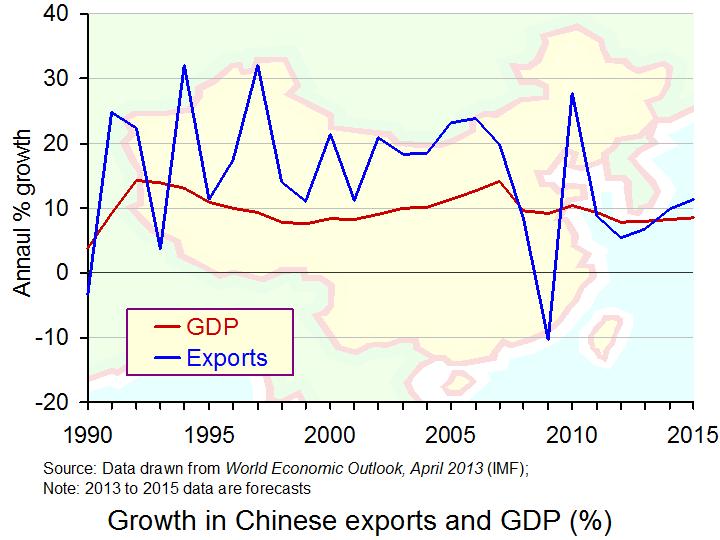 The Chinese economy has seemed relatively unaffected by the economic downturn, yet its economic growth has slowed. Averaging over 10% per annum for the last decade, the growth for January – March 2013 was only 7.7%. This is a decline on the previous 3 months and is lower than expected. If the Chinese economy does begin to slow (relatively speaking), this could present the global economic recovery with an unwelcome obstacle.
The Chinese economy has seemed relatively unaffected by the economic downturn, yet its economic growth has slowed. Averaging over 10% per annum for the last decade, the growth for January – March 2013 was only 7.7%. This is a decline on the previous 3 months and is lower than expected. If the Chinese economy does begin to slow (relatively speaking), this could present the global economic recovery with an unwelcome obstacle.
Many Western economies are reliant on exports to boost their growth figures and with such high demand in China, this is a key export market for many countries. If the Chinese economy continues to slow, consumer spending may even fall and this could mean a reduction in Chinese imports: that is, a reduction in other countries’ exports to China. However, for China’s competitors, the news is better, as with China’s move from a low to middle-income country, other countries will now see an opportunity to grasp a competitive advantage in the production of cheaper products. David Rees from Capital Economics said:
Trade data show that Chinese imports of commodities, and industrial metals in particular, have been falling in recent months … That is bad news for those emerging markets in Latin America, the Middle East, and Africa that predominately export commodities to China. It is not all bad news … To the extent that China’s structural slowdown reflects its transition from low to middle-income status, opportunities will present themselves for other EMs as China moves up the value chain. We are particularly upbeat on the manufacturing-based economies of South East Asia, along with Mexico, Poland, and Turkey.
News is better in Japan, where growth forecasts have been raised to 2.9% over the same period and the economy is expected to grow by 1.5% throughout both 2013 and 2014. Furthermore, suggestions that inflation may also reach 0.7% have boosted confidence. This might be the end of Japan’s troubles with deflation.
So, we have something of a mixed picture across the world, although the IMF predicts a global rate of growth of 3.5% for 2013, which would be an improvement on 2012 figures. The following articles consider the global situation.
Spain slashes economic growth forecast Sky News (26/4/13)
UK avoids triple-dip recession with better than expected 0.3% GDP growth The Guardian, Heather Stewart (26/4/13)
US economy grows 2.5% on buoyant consumer spending BBC News (26/4/13)
Poor French and Spanish jobs data but UK economy returns to growth – as it happened The Guardian, Graeme Wearden and Nick Fletcher (25/4/13)
UK economy avoids tiple-dip recession with 0.3pc GDP growth The Telegraph, Szu Ping Chan (25/4/13)
South Korea economic growth hits two year high BBC News (25/4/13)
S. Korea economy grows at the fastest pace in two years Bloomberg, Eunkyung Seo (25/4/13)
Spain revises down its economic forecast BBC News (26/4/13)
US economy sees broad growth Financial Times, Robin Harding (25/4/13)
Germany’s private sector shrinks as Eurozone decline continues – as it happened The Guardian, Graeme Wearden and Nick Fletcher (23/4/13)
China economic growth lower than forecast BBC News (15/4/13)
China’s slowing economy: what you need to know Bloomberg Business Week, Dexter Roberts (25/4/13)
Modest Growth Pickup in 2013, Projects IMF International Monetary Fund (23/1/13)
Questions
- How is economic growth measured?
- What is meant by a triple-dip recession?
- What has caused the small increase in growth in the UK? Do you think this signifies the start of the economic recovery?
- In the USA, what has caused the growth rate to reach 2.5% and why is it lower than expected?
- Why are growth rates in countries across the world relevant for UK forecasts of economic growth?
- Which factors have allowed the Chinese economy to achieve average growth rates above 10% for the past decade?
- Using an AD/AS diagram, illustrate the desired impact of the Coalition’s policies to boost economic growth.
- With unemployment rising in countries like Spain and France, how might Eurozone growth be affected in the coming months?
- Japanese growth is looking positive and inflation is expected to reach about 0.7%. Why is it that Japan has suffered from deflation for so many years and why is this a problem?
 The link below is to an article by Bill Gates, founder of Microsoft. He argues that per-capita GDP is a poor indicator of development, especially in Sub-Saharan Africa.
The link below is to an article by Bill Gates, founder of Microsoft. He argues that per-capita GDP is a poor indicator of development, especially in Sub-Saharan Africa. But although indicators such as this capture more elements of development than simple per-capita GNP or GNY, there are still serious shortcomings. A major problem is the lack of and inaccuracy of statistics, especially when applied to the rural subsistence and informal urban sectors. The problem is recognised and some countries are trying to address the problem (see the second article below), but the problem is huge. As Gates says:
But although indicators such as this capture more elements of development than simple per-capita GNP or GNY, there are still serious shortcomings. A major problem is the lack of and inaccuracy of statistics, especially when applied to the rural subsistence and informal urban sectors. The problem is recognised and some countries are trying to address the problem (see the second article below), but the problem is huge. As Gates says:








